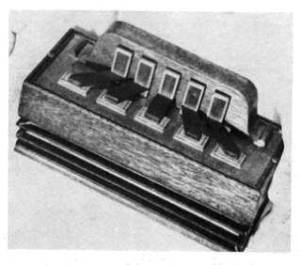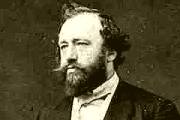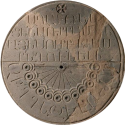

First Accordion in the world by Cyrill Demian and sons
Cyrill Demian (1772–1849) of Armenian origin, made his living as an organ and piano maker, with his two sons Karl and Guido, in Mariahilfer Straße No. 43 in Vienna, Austria. On May 6, 1829, Cyrill and his two sons presented a new instrument to the authorities for patent - the accordion. The patent was officially granted on May 23, 1829.
http://www.bookofdaystales.com/tag/demian/
On this date in 1829 Cyrill Demian (1772–1849) received an official patent from the Vienna patent office for a new instrument he called an accordion. Thus, he is generally credited with the invention. A few give credit to Christian Friedrich Ludwig Buschmann (who also claims to have invented the harmonica) but there is no evidence for either claim apart from a few jottings that Buschmann himself made. His claim to have invented the harmonica is clearly false because they were on sale in Austria 3 years before he says he invented the instrument. Demian is our man.

Cyrill Demian was an Armenian from the Romanian city of Gherla (ancient Armenopolis) who moved to Vienna and worked as an organ and piano maker, with his two sons Karl and Guido, in Mariahilfer Straße No. 43 in Vienna. His new instrument was a modification of the Handäoline, comprising a small manual bellows and five keys. As noted in his own description and patent application, the instrument was what we now call a push-pull accordion, that is it produced a different note on each key depending on whether the bellows were pushed or pulled. Five keys would give a few notes more than an octave in a diatonic scale and major chords would be easy to produce.
His description is translated here from the original German:
Its appearance essentially consists of a little box with feathers of metal plates and bellows fixed to it, in such a way that it can easily be carried, and therefore traveling visitors to the country will appreciate the instrument.
It is possible to perform marches, arias, melodies, even by an amateur of music with little practice, and to play the loveliest and most pleasant chords of 3, 4, 5 etc. voices after instruction.
1st – In a box 7 to 9 inches long, 3½ inches wide and 2 inches high, feathers of metal plates are fixed, which were known for more than 200 years as Regale, Zungen, Schnarrwerk, in organs.
2nd – With bellows fixed to the above box and its 5 claves fixed below, even an amateur of music can play the loveliest and most moving chords of 3, 4 and 5 voices with very little practice.
3rd – Each claves or key of this instrument allows two different chords to be heard, as many keys are fixed to it, double as many chords can be heard, pulling the bellows a key gives one chord, while pushing the bellows gives the same key a second chord.
4th – As this instrument can be made with 4, 5 and 6 or even more claves, with chords arranged in alphabetical order, many well known arias, melodies and marches, etc. may be performed similar to the harmony of 3, 4 and 5 voices, with satisfaction of all anticipations of delicacy and vastly amazing comfort in increasing and decreasing sound volume.
5th – The instrument is of the same size as the attached illustration, with 5 claves and 10 chords, not heavier than 32 to 36 Loth [1 Loth = approx. 16 gm], only if there are more chords will it become longer and some Loths heavier, so it is easy and comfortable to carry and should be a welcome invention for travelers, country and parties visiting individuals of both sexes, especially as it can be played without the help of anybody.[1]
With the cover of the bellows, the entire instrument may be doubled, in order to play more chords or more single tones, in this case, keyboard, the bellows remain in the middle, while each hand controls in turn, either the claves or the bellows.
The above-mentioned duplication of the instrument or adding more chords, would not make anything better to anybody, or give something new, as only the parts would increase, and the instrument more expensive and heavier. The instrument costs 12 to 16 Marks the difference in price results in a more elegant or worse-looking appearance.
From humble beginnings a welter of different kinds of accordions came forth. Many more right hand (treble) keys were added, as were left hand (bass) keys. More reeds (what are called “feathers” here) made richer sounds which could be added or subtracted via stops (equivalent of organ stops), and so forth.
In the 19th century the accordion eventually supplanted the fiddle as the staple instrument for dance music in northern Europe, because of the relative ease of playing in comparison with the fiddle. Accordion reeds are permanently tuned, so it is hard/impossible to play out of tune, and the arrangement of the keys makes production of major chords very simple. If it is tuned in C major, for example, the first 3 keys played together by pushing the bellows produce the notes C E G (the tonic major chord).
Here’s a video of John Spiers trying out a new push-pull accordion, called a melodeon in England. John is the son of a very old friend of mine, and is quite well known in the English folk scene. I played this kind of instrument for many years, but have retired and do not own one any more – otherwise I would give you a sample of my own playing.
https://www.youtube.com/watch?time_continue=36&v=uwWp_yxKVRc
Because Demian was Armenian I’ll choose an Armenian recipe to celebrate him even though the accordion was born in Vienna. I’ve given plenty of Viennese recipes and precious few Armenian ones. Lamb and bulgar are classic Armenian ingredients, so here’s a lamb meatball dish that involves both. You can think of the meatballs as lamb stuffed with lamb. The influence of Indian cuisine should be obvious to those who know kofta.
Kufta Ingredients
Stuffing
- 1 lb ground lamb
- 2 onions, peeled and finely chopped
- ½ cup green bell pepper, finely chopped
- 3 tbsp fresh parsley, chopped
- ¼ cup pine nuts, toasted and chopped
- 1 tsp paprika
- ½ tsp mint leaves finely chopped
- ½ tsp ground cinnamon
- ½ tsp dried basil
- salt and freshly ground black pepper
Outer layer
- 1½ lb lamb, finely ground
- ¾ cup fine bulgur, soaked 20 minutes in water and drained
- 1 onion, peeled and finely chopped
- 1 tbsp chopped parsley
- salt and freshly ground black pepper
To cook
- 4 pints chicken stock
- olive oil
Instructions
For the filling, sauté the lamb in a skillet over medium-high heat with a trace of olive oil. When thoroughly browned add the onions, green pepper and parsley and cook for about 10 to 15 minutes, until the vegetables have softened. Add the spices and season to taste with salt and pepper. Cook for 10 more minutes, then place in a bowl and chill thoroughly.
Chill completely.
To finish and cook, mix the outer layer ingredients together in a food processor. You want this outer layer to be light and fluffy, so mix well so that air is incorporated.
Shape the filling into balls the size of walnuts.
Shape the outer layer into round patties that are large enough to wrap around the filling. Place one ball of filling inside the outer layer, and then wrap the outer layer around the filling so that it is completely and evenly covered. Sorry, this takes practice.
Bring the stock to a simmer in a large stock pot. Add the meatballs a few at a time, cover and simmer for about 8 to 10 minutes. When they are cooked the meatballs will rise to the surface.
You can serve the kufta in some broth, or with plain boiled rice and yoghurt.
SOURCE
http://www.bookofdaystales.com/tag/demian/
https://en.wikipedia.org/wiki/Cyrill_Demian
wikipedia:
 Cyrill Demian (Arm. Կյուրեղ Դեմյան) (1772–1849) was an Austrian inventor of Armenian (Armenopolis) origin, who made his living as an organ and piano maker with his two sons, Karl and Guido, in Mariahilfer Straße No. 43 in Vienna, Austria. On May 6, 1829, Cyrill and his sons presented a new instrument to the authorities for patent - the accordion. The patent was officially granted on May 23, 1829.[1]
Cyrill Demian (Arm. Կյուրեղ Դեմյան) (1772–1849) was an Austrian inventor of Armenian (Armenopolis) origin, who made his living as an organ and piano maker with his two sons, Karl and Guido, in Mariahilfer Straße No. 43 in Vienna, Austria. On May 6, 1829, Cyrill and his sons presented a new instrument to the authorities for patent - the accordion. The patent was officially granted on May 23, 1829.[1]
Description of the accordion
Demian's accordion was described in the original German patent as follows: "Its appearance essentially consists of a little box with reeds of metal plates and bellows fixed to it, in such a way that it can easily be carried, and therefore traveling visitors to the country will appreciate the instrument. It is possible to perform marches, arias, melodies, even by an amateur of music with little practice, and to play the loveliest and most pleasant chords of 3, 4, 5 etc. voices after instruction."[1]
Demian's instrument bore little resemblance to modern instruments. It only had a left hand button board, with the right hand simply operating the bellows. One key feature for which Demian sought the patent was the playing of an entire chord by depressing only one key. His instrument also could sound two different chords with the same key, one for each bellows direction (a bisonoric action). At that time in Vienna, mouth harmonicas with Kanzellen (chambers) had already been available for many years, along with bigger instruments driven by hand bellows. The diatonic key arrangement was also already in use on mouth-blown instruments. Demian's patent thus presented a new instrument for accompanying singers or other musicians: His accordion could be played with the right and the left hand simultaneously, differend from the way that earlier chromatic hand harmonicas were played, and was small and light enough for travelers to carry. The patent also described instruments with both bass and treble sections, although Demian preferred the bass-only instrument, owing to its cost and weight advantages.[2]
One of these instruments was given to the musical instrument maker Johannes Dillner in Sweden by the Swedish Princess Margareta Brahe in the late 1820s and is now privately owned.[3]
The first accordion debate
The advent of the accordion is the subject of debate among researchers. Some historians credit Christian Friedrich Ludwig Buschmann as the inventor of the accordion, but most others give the distinction to Cyrill Demian, an Armenian from the Transsylvanian town of Szamosújvár (Gherla) (ancient Armenopolis) living in Vienna, who patented his accordion in 1829, thus coining the name. A modification of the Handäoline, Demian's invention comprised a small manual bellows and five keys, although, as Demian noted in a description of the instrument, extra keys could be incorporated into the design. Numerous variations of the device soon followed.[4]
The construction of Demian's accordion
(Translated from the original German manuscript)
1st – In a box 7 to 9 inches long, 3½ inches wide and 2 inches high, feathers of metal plates are fixed, which were known for more than 200 years as "Regale, Zungen, Schnarrwerk," in organs.
2nd – With bellows fixed to the above box and its 5 claves fixed below, even an amateur of music can play the loveliest and most moving chords of 3, 4 and 5 voices with very little practice.
3rd – Each claves or key of this instrument allows two different chords to be heard, as many keys are fixed to it, double as many chords can be heard, pulling the bellows a key gives one chord, while pushing the bellows gives the same key a second chord.
4th – As this instrument can be made with 4, 5 and 6 or even more claves, with chords arranged in alphabetical order, many well known arias, melodies and marches, etc. may be performed similar to the harmony of 3, 4 and 5 voices, with satisfaction of all anticipations of delicacy and vastly amazing comfort in increasing and decreasing sound volume.
5th – The instrument is of the same size as the attached illustration, with 5 claves and 10 chords, not heavier than 32 to 36 Loth [1 Loth = approx. 16 g, MW], only if there are more chords will it become longer and some Loths heavier, so it is easy and comfortable to carry and should be a welcome invention for travelers, country and parties visiting individuals of both sexes, especially as it can be played without the help of anybody.[1]
Bellows
With the cover of the bellows, the entire instrument may be doubled, in order to play more chords or more single tones, in this case, keyboard, the bellows remain in the middle, while each hand controls in turn, either the claves or the bellows.
The above-mentioned duplication of the instrument or adding more chords, would not make anything better to anybody, or give something new, as only the parts would increase, and the instrument more expensive and heavier. The instrument costs 12 to 16/M M, the difference in price results in a more elegant or worse-looking appearance.
"We think that it is the most excellent innovation, that with one claves, a complete chord can be played."[1]
In popular culture
In the comic strip Garfield, Jon states that Demian is his hero.[5]
In the colombian novel Antes del Juglar, the author makes a fictional narrative about the making of the accordion, taking Cyrill Demian's son, Guido Demian, as central character.[6]
References
- ^ Jump up to:a b c d "Demian's Accordion Patent". A Short History of the Free-Reed Instruments in Classical Music. The Classical Free-Reed, Inc. Archived from the original on June 19, 2009. Retrieved May 21, 2018.
- ^ German Text: "Mit den Dekel des Balges, läßt sich das ganze Instrument verdoppeln, so daß man dadurch die Accorde vermehrt, oder auch mit einzelne Töne spielen kann, in diesem Fall, muß ein zweyter Einsatz mit Federn, und auch eine 2te Claviatur dazu kommen, der Blasebalg bleibt in der Mitte, jede Hand dirigirt abwechselnd, entweder die Claves, oder den Balg. Durch eine obengenannte Verdoplung des Instruments oder durch Vermehrung der Accorde, würde niemand etwas verbessern, oder was neues liefern, weil nur die Bestandtheile dadurch vermehrt, das Instrument theurer und schwerer wird." Translation of this snip: With the Cover of the bellows the instrument can be duplicated, so the amount of Chords or single notes can be enlarged, or one can sound single notes, in this case, a second part with springs (free reeds) and also a second keyboard must be added, the bellows are in between these two parts, both hands push buttons and push and pull the bellows at the same time or alternatively. Through this doubling or increasing of chords within the instrument nothing new is invented or improved by someone else, because only the amount of similar parts is increased and the Instrument is heavier and more expensive.German full text Archived 18 July 2011 at the Wayback Machine
- ^ Mette Müller, Lisbet Torp (eds.): Musikkens tjenere. Forsker, Instrument, Musiker. Musikhistorisk Museums, København 1998, ISBN 978-87-7289-466-9. (Series: Meddelelser fra Musikhistorisk Museum og Carl Claudius Samling ISSN 0900-2111 – 100 års Jubilæumsskrift) (in Swedish)
- ^ Cyrill Demian at the Encyclopædia Britannica
- ^ Davis, Jim (March 30, 1999). "Garfield of the day". Retrieved May 21, 2018.
- ^ Garnica, Jorge Ignacio (17 April 2019). Antes del Juglar. (1st ed.). Bogotá: Calixta Editores S.A.S. ISBN 9789585481640. ISBN 978-958-5481-64-0, ISBN 978-958-5481-63-3.


